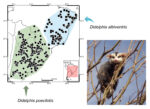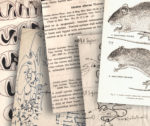Taxonomic novelties in Didelphis albiventris Lund, 1840 and revalidation of Didelphis poecilotis A. Wagner, 1842 (Didelphimorphia, Didelphidae)
M. Amelia Chemisquy, Raúl E. González-Ittig, Gabriel M. MartinIn a recent article we showed that Didelphis albiventris might be separated into two taxonomic entities. Molecular evidence, environmental niche modelling, and qualitative morphological characters indicate that there are two clearly separated groups, one including specimens from central and northern Brazil, and the other comprising Argentina, Uruguay, Paraguay, Bolivia, and southern Brazil. In this contribution we formalize the splitting of the white-eared opossum in two species, D. albiventris for the northern group and D. poecilotis for the southern group. We provide an emended diagnosis for both species and information on type specimens and distribution.
Novedades taxonómicas en Didelphis albiventris Lund, 1840 y revalidación de Didelphis poecilotis A. Wagner, 1842 (Didelphimorphia, Didelphidae). En un artículo reciente demostramos que Didelphis albiventris podría separarse en dos entidades taxonómicas. Evidencias moleculares, el modelado del nicho ambiental y diversos caracteres morfológicos indican que existen dos grupos claramente separados, uno que incluye especímenes del centro y norte de Brasil y otro que comprende Argentina, Uruguay, Paraguay, Bolivia y el sur de Brasil. En esta contribución formalizamos la división de la comadreja overa en dos especies, D. albiventris para el grupo norte y D. poecilotis para el grupo sur. Presentamos diagnosis enmendadas para ambas especies e información sobre los ejemplares tipo y su distribución.


